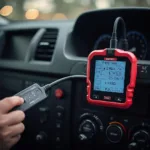Subaru began implementing OBD2 compliance in its US-market vehicles starting in the 1996 model year. This means that if your Subaru is from 1996 or later, it should be OBD2 compliant. Understanding this transition year is crucial for anyone working with Subaru diagnostics.
Understanding the OBD2 Mandate for Subaru
The OBD2 (On-Board Diagnostics, second generation) standard was mandated in the United States by the Environmental Protection Agency (EPA) as part of the Clean Air Act Amendments of 1990. This regulation required all vehicles sold in the US from 1996 onwards to be equipped with OBD2 systems. This standardization ensured a universal method for diagnosing and troubleshooting emissions-related problems. For Subaru owners and mechanics, this meant a significant change in how they approach vehicle diagnostics.
Why 1996 Was a Pivotal Year for Subaru OBD2
Prior to 1996, Subaru, like many other manufacturers, used proprietary diagnostic systems. These systems varied significantly between makes and models, requiring specialized tools and knowledge. The OBD2 mandate leveled the playing field, allowing for generic OBD2 scanners to be used across all compliant vehicles, including Subarus. This standardization streamlined the diagnostic process and made it more accessible to both professionals and DIY enthusiasts.
Identifying OBD2 Compliance in Your Subaru
If you’re unsure whether your Subaru is OBD2 compliant, there are a few ways to check:
- Check the Model Year: As mentioned, any Subaru manufactured for the US market from 1996 onwards should be OBD2 compliant.
- Look for the OBD2 Port: The OBD2 port is typically located under the dashboard, often near the steering column or the center console. It’s a trapezoidal, 16-pin connector.
- Check the Vehicle Emissions Control Information (VECI) Label: This label, usually found under the hood, provides information about the vehicle’s emissions system, including its OBD2 compliance status.
Subaru Models and OBD2 Compliance
While all Subarus from 1996 onwards are OBD2 compliant, some earlier models might have partial OBD2 implementation. It’s important to consult the vehicle’s documentation or use an OBD2 scanner to confirm full compliance.
Benefits of OBD2 for Subaru Owners
The introduction of OBD2 brought several benefits for Subaru owners:
- Simplified Diagnostics: OBD2 standardized the diagnostic process, making it easier for mechanics to identify and fix issues.
- Cost-Effective Repairs: Faster diagnostics translate to lower labor costs and more efficient repairs.
- Improved Emissions Control: OBD2 helps ensure vehicles are running efficiently and minimizing their environmental impact.
- Enhanced Vehicle Performance: Addressing issues identified through OBD2 diagnostics can improve overall vehicle performance and fuel efficiency.
“OBD2 revolutionized how we diagnose and repair vehicles,” says automotive expert John Miller, ASE Certified Master Technician. “For Subaru owners, this meant a more straightforward and efficient approach to maintaining their cars.”
Common OBD2 Codes in Subarus
While OBD2 codes are standardized, some are more common in certain makes and models. Some common OBD2 codes encountered in Subarus include:
- P0420: Catalyst System Efficiency Below Threshold (Bank 1)
- P0301 – P0304: Cylinder Misfire Detected (Cylinders 1-4)
- P0171: System Too Lean (Bank 1)
Using an OBD2 Scanner on Your Subaru
Using an OBD2 scanner on your Subaru is a relatively simple process. Simply locate the OBD2 port, plug in the scanner, and turn the ignition to the “on” position (without starting the engine). The scanner will then communicate with the vehicle’s onboard computer and retrieve any stored diagnostic trouble codes (DTCs).
“With the right OBD2 scanner, Subaru owners can gain valuable insights into their vehicle’s health,” adds Sarah Chen, an automotive engineer with over 15 years of experience. “This empowers them to make informed decisions about maintenance and repairs.”
Conclusion
Knowing when Subaru started using OBD2 is essential for anyone involved in diagnosing or repairing these vehicles. The 1996 model year marked the beginning of OBD2 compliance for Subaru in the US, offering significant advantages in terms of diagnostics, repairs, and emissions control. Utilizing an OBD2 scanner and understanding the common codes can help Subaru owners maintain their vehicles effectively and prevent costly repairs.
FAQ
- Are all Subarus OBD2 compliant? All US-market Subarus from 1996 onwards are OBD2 compliant.
- Where is the OBD2 port located in a Subaru? It’s typically located under the dashboard, near the steering column or center console.
- What are some common OBD2 codes for Subarus? P0420, P0301-P0304, and P0171 are some common ones.
- How do I use an OBD2 scanner on my Subaru? Plug the scanner into the OBD2 port, turn the ignition on, and follow the scanner’s instructions.
- What are the benefits of OBD2 for Subaru owners? Simplified diagnostics, cost-effective repairs, improved emissions control, and enhanced vehicle performance.
- Can I diagnose my pre-1996 Subaru with an OBD2 scanner? It may have partial OBD2 compatibility, but consult the vehicle’s documentation.
- Where can I find more information about OBD2 codes? The OBDFree website has a wealth of resources about OBD2 codes.
For further assistance, please contact us via WhatsApp: +1(641)206-8880, Email: [email protected] or visit us at 789 Elm Street, San Francisco, CA 94102, USA. Our customer service team is available 24/7.
